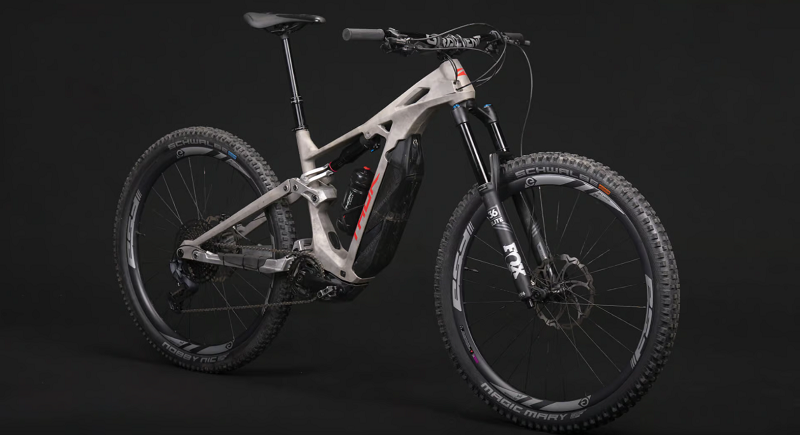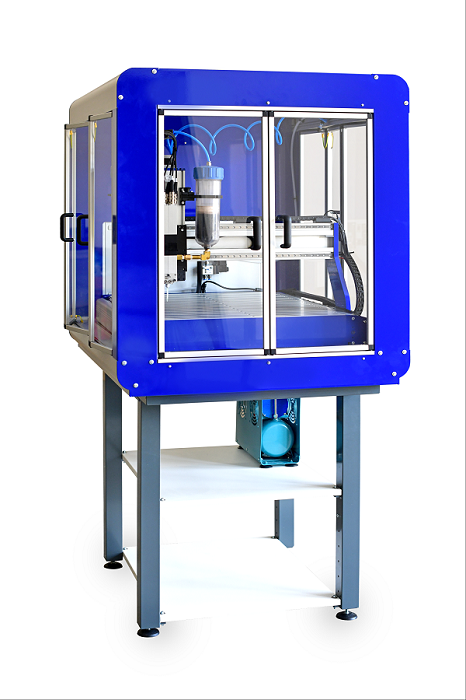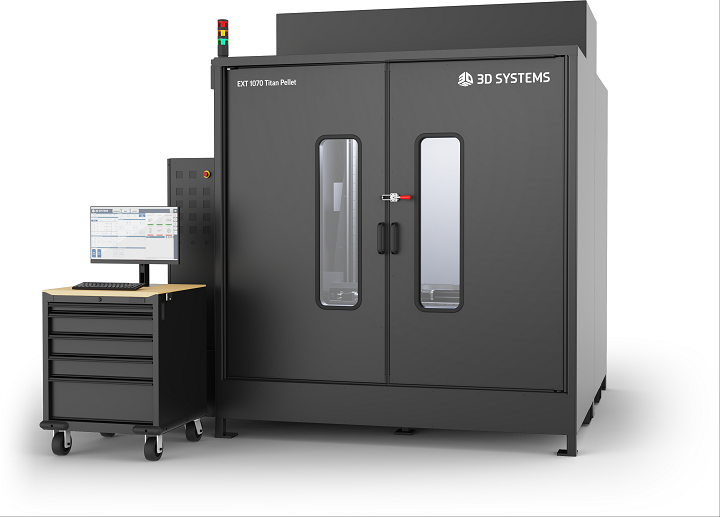In today’s 3D Printing News Briefs, Chromatic 3D Materials has expanded its range of printers for polyurethanes, IN-VISION launched a gantry system for nearly unlimited building size in polymer 3D printing, and additive manufacturing-focused training center Matrix Moon purchased the 3D Systems EXT Titan Pellet 3D printer. EOS North America and its Additive Minds group launched an online AM analysis tool. Finally, to prototype the carbon fiber frame for its next eMTB, Thok is working with Materialise.
Chromatic 3D Materials Expands Polyurethane 3D Printer Range
3D printing technology company Chromatic 3D Materials announced the expansion of its its RX-Flow printer series for thermoset polyurethane parts with the new RX-Flow 2500. The system maintains the speed, quality output, and cost efficiency of the larger RX-Flow printers, but at a more compact 348 x 543 x 194 mm workspace and sub-$30,000 starting price. The smaller RX-Flow 2500, designed to print high-quality thermoset polyurethanes for consumer and industrial applications that require flexibility and durability, features 5,100 mm per minute print speeds along the X and Y axes, and 3,000 mm per minute along the Z axis. The printer also minimizes material waste, and by forgoing molds, can print parts at a lower cost. Depending on size and shape, it can print at a rate of 1 part/10 seconds, and works with Chromatic’s 3D printable polyurethanes with Shore A hardness ranging from 50-90.
“RX-Flow™ 2500 is a compact industrial 3D printer that pushes the boundaries of performance and speed,” explained Cora Leibig, CEO and Founder of Chromatic 3D Materials. “It empowers manufacturers, researchers and innovators to bring their ideas to life with unprecedented efficiency by accelerating the production process and reducing time-to-market without compromising quality.”
IN-VISION Launches Gantry System for Nearly Unlimited Building Size

Gantry System with two high-performance HELIOS light engines: scrolling opens new dimensions for
system designers. (Photo credit: IN-VISION)
Austrian company IN-VISION Technologies AG, which develops and manufactures high-precision optical systems for industrial applications, has developed and launched a gantry system for polymers that’s able to print nearly unlimited sizes. The system uses a very precise portal and up to four of its high-powered HELIOS X Light Engines scrolled over the image plane, along with two projectors and precisely aligned multiheads that move over the build area and are managed live with sensor-based compensation. It features a width of 415 mm, but can be expanded to nearly one meter, which obviously opens up a lot of large-format possibilities. The gantry system, with applications in lithography, screen printing, and 3D printing, is built to customer requirements and can be delivered immediately.
“No, we are not about to start building printers on our own; this is a job we are happy to leave to our customers, but we love to share our know-how with them and provide them with almost turnkey solutions for their projects,” stated Christof Hieger, the CTO of IN-VISION.
Matrix Moon Brings 3D Systems’ EXT Titan Pellet 3D Printer to India
Additive manufacturing-focused training center Matrix Moon is working to accelerate AM in India with the purchase of an EXT 1070 Titan Pellet 3D printer from 3D Systems (NYSE:DDD). Also a 3D Systems reseller, Matrix Moon is the first in the country to install this unique platform, and will use it to more cost-effectively and efficiently deliver a variety of customer applications, including end-use parts for HVAC, consumer goods, aerospace, and automotive industries, and tooling, patterns, and molds for foundries and plastics manufacturers. The company selected the configuration that includes an optional milling spindle tool head, which enables both additive and subtractive manufacturing processes, and with their proprietary pellet extrusion technology, 3D Systems’ large-format EXT Titan Pellet systems can manufacture parts up to 10 times faster than filament printing, with 10 times less the material costs. Matrix Moon will also print sample parts on the system from its demo center, and prospective customers will be able to validate its capabilities before purchasing their own.
“Today I am extremely delighted and filled with immense pride to announce that Matrix Moon is the only company in India to offer 3D Systems’ EXT Titan Pellet 3D printer. This cutting-edge global-grade technology is set to change the face of manufacturing in India. Imagine printing parts as tall as six feet and machining it in the same printer for your end-use production applications. This will now be possible with our latest and unique offering,” said Abhinav Garje, CEO, Matrix Moon Private Limited. “With our continued focus on Skill India and Make-in-India missions, I believe that the EXT Titan Pellet 3D printer has the potential to transform assembly lines and how products are manufactured in India. Along with 3D Systems, we not only endeavor to augment the adoption of additive manufacturing in production but also to make India a global manufacturing hub with such pioneering technology. EXT Titan Pellet is a critical step in that direction.”
EOS Launches Free Online 3D Printing Analysis Tool
If you’ve ever looked at an object or part and wondered if it could be 3D printed, all you need to do is ask! EOS North America, along with its Additive Minds applied engineering group, launched a no-cost part analysis tool, called quite simply “Can I 3D Print This,” to help answer this question. EOS worked with CASTOR to develop the web-based tool, which allows organizations to input information about their desired application into a user-friendly platform. Then, an analysis is generated, including cost estimation, recommended material, predicted production time, and a recommended EOS printer, and the data is put into a downloadable report to help users determine whether or not that particular thing can be 3D printed. The tool is tailored to laser powder bed fusion (LPBF) industrial 3D printing, and was designed for both metals and polymers; plus, if you want, Can I 3D Print This will open a direct line of collaboration with Additive Minds. You’re limited to analyzing five parts, but by working with the team, you can complete larger batch analysis of applications or assemblies.
“For those who are new to AM, the journey often begins with the most basic question about applications or assemblies: ‘Can I 3D Print This?’ Despite its proven advantages and widespread adoption, many companies still deem AM an emerging technology and are hesitant to augment their traditional manufacturing processes. Our new Can I 3D Print This tool helps with initial decision-making by empowering potential users to explore and gather information about the promise of AM within their organization,” explained Dr. David Krzeminski, Senior Consultant for EOS North America Additive Minds.
Can I 3D Print This is only available for North American users at the moment, but the company is looking into offering it globally.
Thok & Materialise Use Metal AM to Prototype eMTB Frame

Thok partnered with Belgium’s Materialise to 3D print a test frame for an upcoming “light e-MTB” (Image credit: Thok)
Finally, Italian company THOK E-Bikes, founded in 2017, is working with Materialise to 3D print the prototype of a frame design for its latest eMTB (electric mountain bike), the Project 4, or P4. Once it officially launches next year, the P4, which is being ridden in its current form on technical trails in Finale Ligure on the Italian Riviera, will be the company’s first light eMTB, as it will be made out of carbon fiber. Materialise used selective laser melting (SLM) technology to print the new prototype frame in an aluminum and silicon alloy, which allowed the team to design and appraise different component configurations and geometries without having to produce multiple versions for testing. Plus, the technology helps speed up the manufacturing process and cuts back on waste. While the THOK development team is still working out the final design, it’s expected to feature a lightweight Bosch Performance Line SX mid-drive motor, which can produce 55 Nm (40.5 lb.ft) of torque, peaks at 600 watts, and can be optioned with 400-Wh, 545-Wh, or 725-Wh batteries.
“It is impossible to obtain a running prototype and reproduce the necessary battery and motor integration with a traditional method. There are components that are made by hydroforming, which require molds, and which would not otherwise be prototype-able. Even carbon prototypes are not functional, they do not hold up on long field testing sessions,” explained Luca Burzio, THOK’s industrial designer. “In this sense, the first fully molded full-suspended e-bike we made solves a big problem.”
THOK hasn’t reported a price or release date yet, but once the P4 is renamed and launched with a carbon frame, it’s likely that the cost will not be in the low-to-middle end of the eMTB market.
Subscribe to Our Email Newsletter
Stay up-to-date on all the latest news from the 3D printing industry and receive information and offers from third party vendors.
You May Also Like
Gorilla Sports GE’s First 3D Printed Titanium Cast
How do you help a gorilla with a broken arm? Sounds like the start of a bad joke a zookeeper might tell, but it’s an actual dilemma recently faced by...
Nylon 3D Printed Parts Made More Functional with Coatings & Colors
Parts 3D printed from polyamide (PA, Nylon) 12 using powder bed fusion (PBF) are a mainstay in the additive manufacturing (AM) industry. While post-finishing processes have improved the porosity of...
$25M to Back Sintavia’s Largest Expansion of Metal 3D Printing Capacity Since 2019
Sintavia, the digital manufacturing company specializing in mission-critical parts for strategic sectors, announced a $25 million investment to increase its production capacity, the largest expansion to its operations since 2019....
Velo3D Initiates Public Offering in a Bid to Strengthen Financial Foundations and Drive Future Growth
Velo3D (NYSE: VLD) has been among a number of publicly traded 3D printing firms that have attempted to weather the current macroeconomic climate. After posting a challenging financial report for 2023,...


































